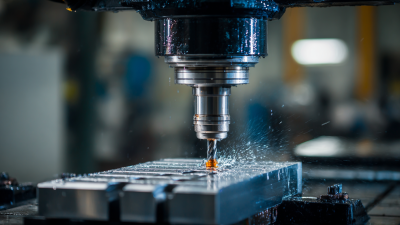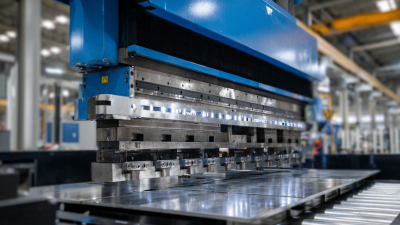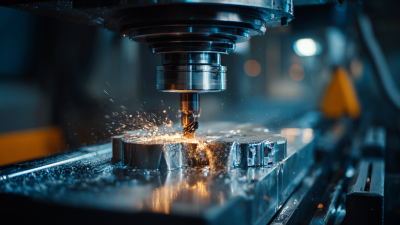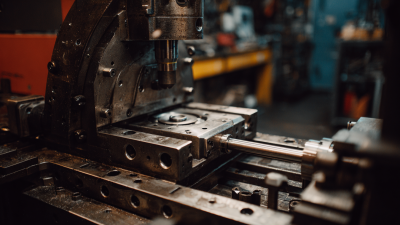- About US
- IMC
- By Equipment
-
- Manufactures
- Blog
Maximizing Metal Forming Efficiency: The Evolution and Future of Brake Press Machines in Manufacturing
In today's rapidly evolving manufacturing landscape, the efficiency of metal forming processes has become a pivotal factor in determining competitive advantage. The brake press machine, a cornerstone of sheet metal fabrication, plays an essential role in enhancing productivity while ensuring precision and accuracy in the bending and shaping of materials. According to a recent industry report by MarketsandMarkets, the global brake press market is projected to reach USD 4.5 billion by 2025, reflecting a compound annual growth rate (CAGR) of 5.8% from 2020 to 2025. This growth emphasizes the increasing need for manufacturers to adopt advanced technologies that optimize production efficiency.
As we delve into the evolution of brake press machines, it becomes evident that innovation is not just about adopting new machinery, but also about integrating intelligent systems for smarter manufacturing. Expert in the field, Dr. John Thompson, a renowned authority on metalworking machinery, stated, "The future of brake press machines lies in their ability to adapt and integrate with Industry 4.0 technologies, significantly reducing downtime and maximizing operational efficiency." This insight encapsulates the shifting paradigm in which manufacturers must embrace both technological advancements and strategic methodologies to stay ahead.
In light of these insights, this article will explore the top 10 trends and innovations transforming the brake press machine sector, highlighting how these developments not only push the boundaries of efficiency but also pave the way for sustainable manufacturing practices in the years to come.

Identifying Key Technological Advancements in Brake Press Machines
The evolution of brake press machines has been significantly shaped by technological advancements that enhance their efficiency and precision in manufacturing. Notably, the integration of computer numerical control (CNC) systems has revolutionized the operation of brake presses, providing manufacturers with the ability to execute complex bending operations with minimal human intervention. This technology not only improves accuracy but also reduces setup times, enabling faster production cycles and allowing for more intricate designs to be realized.
Another key advancement is the development of hydraulic systems that offer greater force control and consistency. Modern brake presses are equipped with advanced sensor technology that monitors various parameters during the forming process, ensuring that the material is processed uniformly and without defects. Additionally, the introduction of advanced materials in machine construction, such as high-strength steels and composites, has led to lighter and more robust machines capable of handling a wider variety of materials and thicknesses. As these technological innovations continue to evolve, they promise to further enhance the effectiveness of brake press machines, positioning them as pivotal tools in the manufacturing landscape.
Evaluating Different Types of Brake Press Machines for Manufacturing Needs
When it comes to maximizing metal forming efficiency, evaluating different types of brake press machines is crucial for meeting diverse manufacturing needs. Hydraulic brake presses, for instance, are known for their versatility and ability to handle a wide range of materials, making them ideal for complex shaping tasks. According to a report by Research and Markets, the global hydraulic press market is expected to reach $5 billion by 2024, emphasizing their growing significance in the manufacturing industry.
On the other hand, mechanical brake presses provide high-speed operation and exceptional precision, suitable for high-volume production environments. Recent studies suggest that these machines can deliver up to 30% faster cycle times compared to their hydraulic counterparts. This speed is vital in reducing operational costs and increasing productivity, particularly in sectors where time is money.
Tips: When selecting a brake press machine, consider the volume of production and the complexity of the parts being manufactured. Investing in a more versatile hydraulic press can provide flexibility for future projects, while a mechanical press might be the best choice for large-scale, repetitive tasks. Moreover, always evaluate the machine's energy efficiency, as some modern models consume significantly less power, leading to long-term savings.
Implementing Best Practices for Brake Press Operation and Maintenance
Brake press machines have become integral to modern manufacturing, and implementing best practices for their operation and maintenance is crucial to maximizing efficiency. According to a report from the Fabricators & Manufacturers Association (FMA), optimized operation procedures can reduce downtime by up to 30%, significantly increasing productivity. Key best practices include regular training for operators to ensure they are proficient in using the equipment, as well as establishing standardized workflows that minimize unnecessary movements during the pressing process.
Maintenance is equally critical; the National Tooling and Machining Association (NTMA) points out that predictive maintenance can extend the lifespan of brake press machines by 20-40%. This proactive approach relies on data analytics to monitor equipment performance and predict failures before they occur. Additionally, adopting advanced lubrication techniques and regularly inspecting hydraulic systems can prevent costly breakdowns and improve overall production efficiency. By prioritizing these best practices, manufacturers can enhance their brake press operations, ensuring they remain competitive in an evolving industry.
Maximizing Metal Forming Efficiency: Brake Press Operation Performance
This chart illustrates the average cycle time and productivity levels of brake press operations over the past five years. The data reflects the efficiency gains achieved through the implementation of best practices in operation and maintenance.
Analyzing the Role of Automation in Enhancing Brake Press Efficiency
The role of automation in enhancing brake press efficiency has become increasingly prominent as manufacturers seek to optimize their production processes. As industries embrace advanced technologies, the integration of AI-driven systems allows for improved workflow and productivity. By leveraging these automated solutions, fabricators can streamline operations from order to cash, effectively reducing lead times and minimizing waste. This evolution is reflected in the growing bending machine market, anticipated to reach USD 16.6 billion by 2034, indicating a robust demand for more efficient manufacturing tools.
In addition to traditional methods, the implementation of automation tools such as automatic pallet changers and press brake robots has significantly transformed sheet metal bending processes. These innovations not only enhance precision and efficiency but also align with the broader trend of investing in productivity growth within the manufacturing sector. As companies continue to seek ways to integrate automation, the future of brake press machines looks promising, driven by the technological advancements that empower manufacturers to achieve higher efficiency levels and adapt to evolving market demands.
Exploring Future Trends in Brake Press Technology and Manufacturing Integration
The evolution of brake press technology has transformed the landscape of metal forming in manufacturing. As industries push towards increased efficiency and precision, the integration of advanced technologies such as automation and smart manufacturing systems becomes paramount. With the introduction of Industry 4.0 concepts, brake press machines are being equipped with IoT capabilities that allow for real-time monitoring and data collection. This integration facilitates predictive maintenance, reducing downtime and ensuring consistent performance. Manufacturers are increasingly adopting these innovations to streamline operations and enhance productivity.
Looking ahead, future trends indicate a shift towards more sophisticated control systems and adaptive algorithms that can optimize the forming process on the fly. CNC (Computer Numerical Control) technologies are becoming more prevalent, allowing for enhanced customization and quicker setup times. Additionally, the use of artificial intelligence in brake press machines is likely to improve decision-making and operational efficiency. As manufacturers seek to stay competitive, the ongoing development of brake press technology will continue to play a critical role in achieving higher levels of accuracy, speed, and integration within the production process. This synergy between innovation and practicality will define the next generation of metal forming machinery.
Maximizing Metal Forming Efficiency: The Evolution and Future of Brake Press Machines in Manufacturing
| Dimension | Current State | Future Trends | Potential Impact |
|---|---|---|---|
| Energy Efficiency | Standard hydraulic systems with moderate energy consumption. | Integration of servo-electric drive systems for higher efficiency. | Reduced operational costs and environmental impact. |
| Automation Level | Manual operations with limited automation features. | Increased use of robotics and AI for enhanced automation. | Faster production cycles and reduced human error. |
| Software Integration | Basic CAD/CAM integration with limited feedback mechanisms. | Advanced software integrating real-time data analytics. | Improved decision-making and production efficiency. |
| Material Usage | Conventional materials with moderate waste levels. | Adoption of advanced materials and recycling practices. | Lower waste and sustainable manufacturing practices. |
| Process Monitoring | Manual inspections and basic monitoring tools. | Integration of IoT for continuous process monitoring. | Enhanced quality control and predictive maintenance. |
Related Posts
-

Innovative Solutions for Efficient CNC Press Brake Machine Operations
-

The Ultimate Guide to CNC Metal Cutting Machines: Choosing the Right Tool for Your Business
-

10 Innovative CNC Press Brake Machine Features You Should Know
-

Why CNC Press Brakes Are Transforming Sheet Metal Fabrication Efficiency in 2023
-

Understanding the Advantages of CNC Metal Cutting Machines in Modern Manufacturing
-

8 Compelling Reasons to Invest in a Bending Machine for Your Business